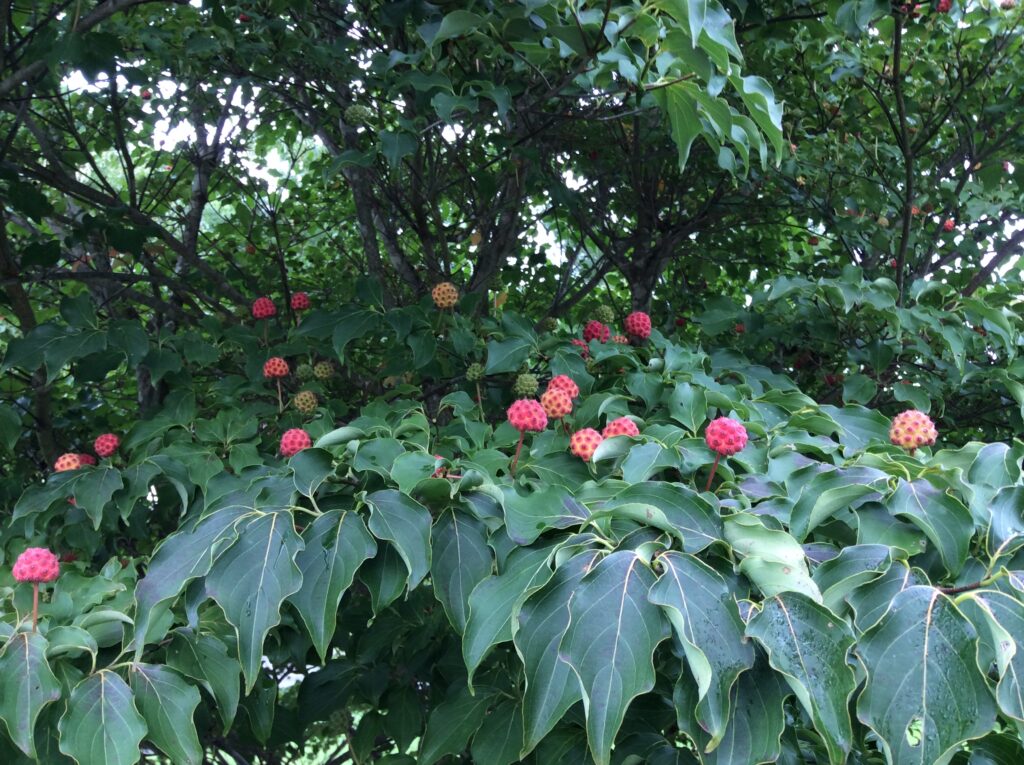
Kousa dogwood fruit, South Carolina. Photo by Green Denane
In the backwoods of Maine where I grew up Dogwoods were small. Perhaps the weather and the species conspired to make them inconspicuous. They did not prepare me for more flamboyant Dogwoods including Kousa. A popular ornamental and escapee, Kousa Dogwood does have edible fruit. Whether you will like it or not is a different debate. When I was in North Carolina studying mushrooms at an agricultural center I noticed the landscaping around the main center was quite coiffured. But next to a lower parking lot where the forest met the pavement was a Kousa Dogwood happily invading the harrow agricultural ground. They were not originally planted for their fruit but rather their attractive blossoms. By the way, one of the ways to identify a Dogwood is to carefully tear a leaf apart across the veins. A latex in them will form threads and hold the two separated parts of the leaf together on white webs. To read more about the Kousa Dogwood go here.
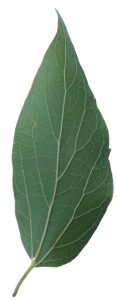
Note the uneven leaf shoulders by the stem and three main veins at the base.
People launch into arguments over the common names of plants. That should not come as a surprise: Botanists get into arguments over the official names of plants. So is the tree a “Sugarberry” or a “Hackberry?” Some will argue the distinction is geographic, other will assert the names apply to different species. I call it a big tree with little burnt-orange fruit that is edible around now. In real estate it is “location, location, location.” Hackberries-Sugarberries like to be near fresh water such as lakes, ponds, streams or a very reliable irrigation-sprinkler system. They don’t like being waterlogged. But you won’t find them on the top of a dry hill either. Usually you can find them up the bank from water. Older trees usually have warty bark, no thorns. Leaves have uneven shoulders, one down or one up, and on the back side of the leaf notice three prominent veins at the base. Often the leaves have many insect galls and or a black smut on them (the latter does not affect the tree or us. It is also found on useable persimmon leaves.) The pea-sized fruit is burnt to medium orange in color sometimes red depending on the species. The entire fruit is edible though the seed is hard. So you can eat the pulp, and or crunch the seed, or mash entire fruits into cakes. To read more about the Hackberry or Sugarberry go here.

Classes are held rain or shine or cold. (Hurricanes are an exception.)
FORAGING CLASSES: There’s no horrible weather predicted for this weekend, so there are two foraging classes. however as a lot of rain perhaps as a storm is expected next week, no classes are scheduled for early September. If the storm is midweek, check for an updated schedule.
Saturday August 26th, Wickham Park, Melbourne Florida, 9 a.m. to noon. Meet at the dog park.
Sunday August 27th, Blanchard Park, Orlando, 9 a.m. meet beside the tennis courts.
For more information, to pre-pay for a class, or to sign up go here.
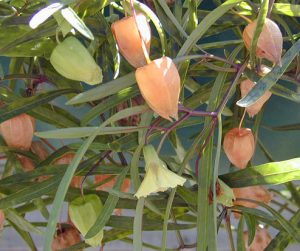
Ground cherries ripen to golden.
From a foraging point of view it was a very berry weekend starting with Coastal Ground Cherries, Physalis angustifolia. Their husks were gold to a tan, dry and papery. Inside the fruit was deep yellow to gold, tangy in taste. Ground cherries ripen from green to gold, getting sweeter and tangier as they go along. But they can often have a bitter aftertaste either from being under ripe or some species just retain some bitterness. A little aftertaste of bitterness is okay but the best is when there is none. Thus one always tastes a ripe ground cherry then you wait a minute or so for any bitterness to appear. While locally Ground Cherries can fruit nearly all year, they do produce a spring and fall crop. In cooler climes — most of North America — they just have one season ripening in late summer and fall. Here our fall crop tends to be better than our spring one. Spring ground cherries can rot on the plant or get damaged by insects and that is also when I tend to find more bitter ones. But this time of year brings out the best in ground cherries. One can find whole, undamaged, very ripe Ground Cherries in significant numbers. You can make a pie out of them if you can manage to get some home uneaten. Incidentally there is a second local ground cherry that resembles the Coastal Ground Cherry. It’s Physalis walteri, also known as Starry-Hair Ground Cherry and Sand Cherry. It has star-shaped hairs on the lower edges of the leaf which are visible with a hand lens. Still has edible berries, however as does P. angulata, and other common Ground Cherry. Some people like to grow P. angulata in their garden. To read more about Ground Cherries go here.

You get the USB, not the key.
Changing foraging videos: My nine-DVD set of 135 videos has been selling for seven years and are still available. They are the same videos I have on You Tube. Some people like to have a separate copy. A second option is a16-gig USB that has those 135 videos plus 15 more. While the videos can be run from the DVDs the videos on the USB have to be copied to your computer to play. They are MP4 files. The150-video USB is $99 and the 135-video DVD set is now $99. The DVDs will be sold until they run out then will be exclusively replaced by the USB. This is a change I’ve been trying to make for several years. So if you have been wanting the 135-video DVD set order it now as the price is reduced and the supply limited. Or you can order the USB. My headache is getting my WordPress Order page changed to reflect these changes. We’ve been working on it for several weeks. However, if you want to order now either the USB or the DVD set make a $99 “donation” using the link at the bottom of this page or here. That order form provides me with your address, the amount — $99 — tells me it is not a donation and in the note say if you want the DVD set or the USB.

Green Deane Forum
Want to identify a plant? Perhaps you’re looking for a foraging reference? You might have a UFO, an Unidentified Flowering Object, you want identified. On the Green Deane Forum we — including Green Deane and others from around the world — chat about foraging all year. And it’s not just about warm-weather plants or just North American flora. Many nations share common weeds so there’s a lot to talk. There’s also more than weeds. The reference section has information for foraging around the world. There are also articles on food preservation, and forgotten skills from making bows to fermenting food.
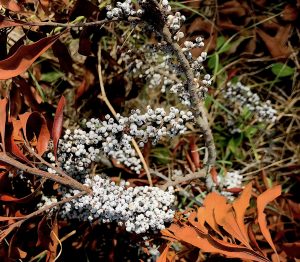
Southern Wax Myrtle berries. Photo by Green Deane
Humans often see beauty in dead plants from bouquets to Christmas wreaths. A woods road’s trimming in offered us an unusual view of Southern Wax Myrtle berries. Light gray they often hide in the green aromatic leaves of this shrub. However when the trimmed leaves browned it revealed the concealed berries. They can be used as a spice when dried and put in a pepper mill. And if you have a lot of them (and the need) they also produce a green wax. If you mix that wax with one quarter tallow it makes a smokeless candle that keeps away biting insects. That chandle, however, is a lot of work. But, if it is all you have to drive away insects it’s much worth it.
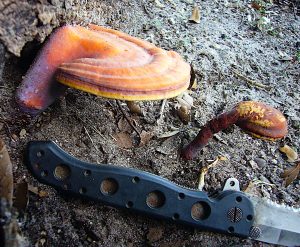
Ganoderma curtisii. Photo by Green Deane
The question isn’t whether Reishi mushrooms grow in North America. The question is what to call them. Some would argue there are only six species of Reishi mushrooms on this continent. Others say many more. Just as the botanical world is in DNA flux so to is the fungal realm. Regardless of the species the Reishis are all Ganodermas, a genus name that that always suffers from translation. One sees Ganoderma translated as “shiny skin.” That’s not exactly right. In Greek it actually means “polished leather.” When I think of shiny skin I think of what my fingers and toes looked like after getting chilblains or frost bite. My skin was shiny. It did not look like polished leather. By the way once you get chilblains you always have them. I can go into a well air-conditioned building in Florida and my fingers and toes will ache from frozen nights spent ice skating 60 years ago.
This is weekly newsletter #571, If you want to subscribe to this free newsletter you can find the sign-up form in the menu at the top of the page.
To donate to the Green Deane Newsletter click here.

